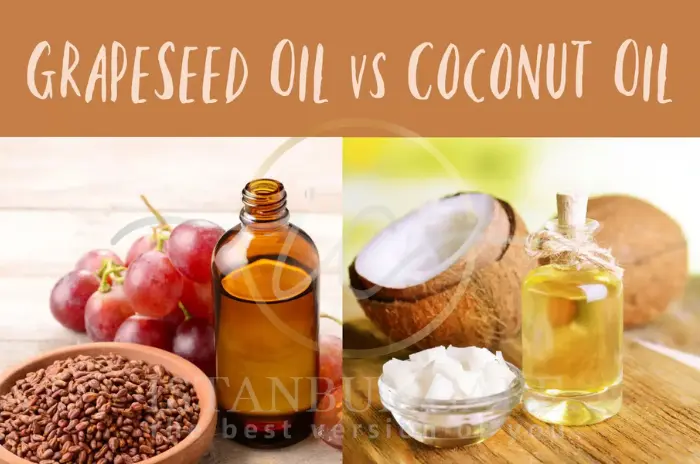Grapeseed oil has emerged as a game-changing ingredient in modern hair care, offering a lightweight yet nourishing solution for various hair concerns. Extracted from grape seeds through cold-pressing or chemical extraction, this natural hair oil provides exceptional moisturizing properties without the heaviness typically associated with traditional hair oils. Whether you’re dealing with frizzy hair, dry scalp, or simply seeking a non-greasy hair oil that adds natural shine, grapeseed oil for hair delivers remarkable results.
Rich in vitamin E, omega-6 fatty acids, and linoleic acid, this lightweight hair oil has become increasingly popular among those with fine hair who previously struggled to find oils that wouldn’t weigh down their strands. The anti-inflammatory properties of grapeseed oil make it particularly beneficial for scalp health, while its molecular structure allows for easy absorption, making it an ideal choice for daily use.

What Is Grapeseed Oil and Why Is It Used in Hair Care?
How Grapeseed Oil Is Made
Grapeseed oil is extracted from the small seeds found within grapes, typically those used in winemaking. The most common extraction methods include cold-pressing, which preserves the oil’s natural nutrients, and solvent extraction, which yields larger quantities. Cold-pressed grapeseed oil retains higher levels of vitamin E and antioxidants, making it the preferred choice for hair care applications. The seeds are first cleaned and dried before undergoing the extraction process, resulting in a light, pale yellow oil with minimal scent.
Natural Nutrients Found in Grapeseed Oil
The nutritional profile of grapeseed oil makes it exceptional for hair care. It contains high concentrations of linoleic acid, an essential fatty acid that helps maintain the hair’s natural moisture barrier. Omega-6 fatty acids present in the oil contribute to scalp health and hair strength. Vitamin E acts as a powerful antioxidant, protecting hair from environmental damage and free radicals. Additionally, the oil contains procyanidins, compounds that may support hair follicle health and potentially promote hair growth.
Why It’s Popular in Hair Products
Grapeseed oil has gained popularity in commercial hair products due to its unique properties. Unlike heavier oils, it provides lightweight moisture without leaving a greasy residue. This makes it particularly appealing for formulating products designed for fine hair or those prone to becoming oily quickly. Its stability and long shelf life also make it an attractive ingredient for manufacturers. The oil’s ability to reduce frizz while adding natural shine has made it a favorite among formulators of leave-in treatments and styling products.
What Makes It Different From Other Oils
What sets grapeseed oil apart from other hair oils is its molecular weight and absorption rate. While coconut oil can feel heavy and argan oil may be too rich for some hair types, grapeseed oil strikes the perfect balance. Its light texture allows it to penetrate the hair shaft more easily, delivering moisture where it’s needed most. The oil’s high linoleic acid content also makes it particularly effective for damaged or chemically-treated hair, as it helps restore the hair’s natural lipid barrier.
Grapeseed Carrier Oil Explained
As a carrier oil, grapeseed oil serves as an excellent base for diluting essential oils or creating custom hair treatments. Its neutral scent and light consistency make it ideal for blending with other oils like rosemary or peppermint for scalp massage. The oil’s stability means it won’t go rancid quickly, making it perfect for DIY hair treatments. When used as a carrier oil, grapeseed oil enhances the delivery of other beneficial ingredients while providing its own moisturizing and protective benefits.
Top Benefits of Grapeseed Oil for Hair
Helps Moisturize Without Weighing Hair Down
One of the most significant advantages of grapeseed oil for hair is its ability to provide deep hydration without the heaviness associated with other oils. The molecular structure of grapeseed oil allows it to penetrate the hair cuticle effectively, delivering moisture to the cortex where it’s needed most. This lightweight hair oil is particularly beneficial for those with fine hair who struggle with products that make their hair appear flat or greasy. Regular use helps maintain optimal moisture levels, preventing dryness and brittleness.
Supports Scalp Health and Hair Strength
The anti-inflammatory properties of grapeseed oil make it excellent for maintaining scalp health. The oil’s omega-6 fatty acids help soothe irritated scalp conditions and may reduce inflammation that can impede healthy hair growth. Vitamin E in the oil protects the scalp from oxidative stress, while linoleic acid helps maintain the scalp’s natural barrier function. Regular scalp massage with grapeseed oil can improve circulation, potentially promoting stronger, healthier hair growth.
Protects Against Breakage and Dryness
Grapeseed oil forms a protective barrier around the hair shaft, helping to prevent moisture loss and environmental damage. The oil’s linoleic acid content is particularly effective at repairing damaged cuticles and reducing porosity. This protection is especially beneficial for color-treated or chemically processed hair, which tends to be more vulnerable to breakage. The moisturizing properties of grapeseed oil help maintain hair elasticity, reducing the likelihood of snapping and splitting.
Adds Natural Shine and Smoothness
The light-reflecting properties of grapeseed oil give hair a natural, healthy shine without appearing greasy. Unlike heavier oils that can make hair look slick, grapeseed oil enhances the hair’s natural luster while maintaining movement and body. The oil smooths the hair cuticle, reducing roughness and creating a silky texture. This natural shine effect is particularly noticeable on dull or damaged hair, where the oil helps restore the hair’s reflective quality.
Lightweight Moisture Without a Greasy Finish
The non-greasy nature of grapeseed oil makes it ideal for daily use, even on hair types that typically become oily quickly. The oil absorbs readily into the hair shaft, leaving behind moisture without residue. This characteristic makes it perfect for use as a leave-in treatment or styling aid. Even those with naturally oily hair can benefit from grapeseed oil, as its balancing properties help regulate sebum production on the scalp.
Soothes Dry or Itchy Scalp
Grapeseed oil provides relief for dry scalp conditions through its deeply moisturizing and anti-inflammatory properties. The oil’s gentle nature makes it suitable for sensitive scalps, while its ability to penetrate deeply ensures lasting hydration. Regular application can help alleviate scalp tightness and discomfort associated with dryness. The vitamin E content provides additional soothing benefits, helping to calm irritated skin and restore comfort.
Reduces Scalp Flakes
The moisturizing action of grapeseed oil can help address dandruff and scalp flaking by improving scalp hydration and health. While not a cure for medical conditions like seborrheic dermatitis, the oil’s ability to maintain scalp moisture can reduce the appearance of dry flakes. The anti-inflammatory properties may also help calm scalp irritation that contributes to flaking. For dandruff treatment, grapeseed oil works best when combined with a comprehensive scalp care routine.
Shields Hair from UV Damage
Grapeseed oil contains natural compounds that provide some protection against UV radiation, though it shouldn’t replace dedicated sun protection products. The vitamin E and other antioxidants in the oil help neutralize free radicals caused by sun exposure. This protection is particularly important for color-treated hair, which is more susceptible to UV-induced fading and damage. Regular use of grapeseed oil can help maintain hair color vibrancy and prevent sun-related dryness.
Tames Frizz and Flyaways
For those struggling with frizzy hair, grapeseed oil offers an effective solution. The oil’s ability to smooth the hair cuticle helps reduce frizz and eliminate flyaways. Its lightweight nature means it won’t weigh down hair while still providing enough control to manage unruly strands. The moisturizing properties address one of the root causes of frizz – dryness – while the oil’s film-forming ability provides humidity protection.
Promotes Scalp Health and Growth
While grapeseed oil isn’t a miracle cure for hair loss, its scalp health benefits may indirectly support healthy hair growth. The improved circulation from scalp massage with the oil, combined with its nourishing properties, creates an optimal environment for hair follicles. The anti-inflammatory properties help maintain a healthy scalp ecosystem, which is essential for normal hair growth cycles. Regular use may help minimize factors that contribute to hair thinning or loss.

How to Use Grapeseed Oil in Your Hair Routine
Daily Leave-In Treatment or Styling Aid
For daily use, grapeseed oil works excellently as a lightweight moisturizer that won’t interfere with your styling routine. Apply 2-3 drops to damp hair, focusing on mid-lengths and ends while avoiding the roots. This method provides all-day moisture protection and frizz control. The oil can also be applied to dry hair as a finishing touch to add shine and smooth flyaways. For fine hair, start with just one drop and gradually increase if needed.
Grapeseed Oil as a Scalp Massage Oil
Scalp massage with grapeseed oil can be both relaxing and beneficial for scalp health. Warm the oil slightly between your palms before applying to the scalp in sections. Use gentle circular motions to massage the oil into the scalp for 5-10 minutes, promoting circulation and absorption. This treatment is particularly beneficial for dry scalp conditions and can be done 1-2 times per week. Leave the oil on for 30 minutes to an hour before shampooing.
Mixing Grapeseed Oil with Other Natural Oils
Grapeseed oil serves as an excellent base for custom oil blends. Mixing grapeseed oil with other oils like argan, jojoba, or rosehip can create targeted treatments for specific hair concerns. For enhanced hair growth benefits, combine with rosemary essential oil. For extra moisture, blend with a small amount of heavier oils like coconut or olive oil. The lightweight nature of grapeseed oil helps balance richer oils, preventing the mixture from becoming too heavy.
Choosing Hair Products with Grapeseed Oil
Look for Lightweight and Nourishing Formulas
When selecting hair products containing grapeseed oil, prioritize formulations that maintain the oil’s lightweight properties. Look for products that list grapeseed oil among the first few ingredients to ensure meaningful concentrations. Nourishing formulas should combine grapeseed oil with complementary ingredients like vitamin E, botanical extracts, or other lightweight oils. Avoid products with heavy silicones or waxes that might counteract the oil’s natural benefits.
Ideal for Fine or Dry Hair Types
Grapeseed oil products are particularly well-suited for fine hair that needs moisture without weight. These formulations typically feature the oil in leave-in treatments, serums, or lightweight conditioning products. For dry hair, look for products that combine grapeseed oil with other moisturizing ingredients to address severe dehydration. The oil’s versatility makes it suitable for various hair textures, from straight to curly, as long as the formulation is appropriate for the hair type.
Pairing with Sulfate-Free Shampoos and Conditioners
To maximize the benefits of grapeseed oil treatments, pair them with sulfate-free shampoos and gentle conditioners. Harsh sulfates can strip away the beneficial oils, reducing their effectiveness. Look for cleansing products that preserve natural oils while removing dirt and buildup. Grapeseed oil works particularly well with protein-free conditioners, as the oil provides moisture balance without overwhelming the hair with too many active ingredients.
Things to Know Before Using Grapeseed Oil
Hair Types That Benefit Most
While grapeseed oil is suitable for most hair types, certain textures and conditions benefit more than others. Fine hair that lacks body but needs moisture finds the perfect balance with this oil. Color-treated hair benefits from the oil’s protective and moisturizing properties. Frizzy hair of any texture responds well to the oil’s smoothing effects. Even naturally oily hair can benefit when the oil is used sparingly and focused on the lengths and ends rather than the scalp.
Frequency and Application Tips
The frequency of grapeseed oil application depends on your hair’s needs and porosity. Fine hair typically benefits from 2-3 times per week application, while thicker or more damaged hair may tolerate daily use. Start with small amounts and gradually increase as needed. For scalp treatments, once or twice weekly is usually sufficient. Always apply to clean, slightly damp hair for best absorption, and remember that a little goes a long way with this concentrated oil.
Potential Side Effects or Sensitivities
While grapeseed oil is generally well-tolerated, some individuals may experience sensitivities. Those with grape allergies should exercise caution and perform a patch test before use. Overuse can lead to buildup, making hair appear greasy or flat. If you notice any scalp irritation, redness, or unusual reactions, discontinue use immediately. Always do a patch test by applying a small amount to your inner elbow and waiting 24 hours to check for any adverse reactions.

Grapeseed Oil vs. Other Popular Hair Oils
Grapeseed Oil vs. Coconut Oil: Which Is Better?
When comparing grapeseed oil vs coconut oil, each offers distinct advantages. Coconut oil provides deep conditioning benefits but can be too heavy for fine hair and may cause protein overload in some hair types. Grapeseed oil offers lightweight moisture that won’t weigh hair down, making it more versatile for daily use. Coconut oil works better for deep conditioning treatments, while grapeseed oil excels as a daily styling aid and scalp health promoter.
Grapeseed Oil vs. Argan Oil: Pros and Cons
Grapeseed oil vs argan oil presents another interesting comparison in hair care. Argan oil is richer and more nourishing but also more expensive and potentially too heavy for some hair types. Grapeseed oil provides similar anti-inflammatory benefits at a more affordable price point with a lighter feel. Argan oil excels for very dry or damaged hair, while grapeseed oil works better for regular maintenance and fine hair types that need gentle moisture.
| Feature | Grapeseed Oil | Coconut Oil | Argan Oil |
|---|---|---|---|
| Texture | Lightweight, non-greasy | Heavy, can solidify | Medium weight |
| Best for Hair Type | Fine hair, all types | Thick, coarse hair | Dry, damaged hair |
| Absorption Rate | Fast absorption | Slow absorption | Moderate absorption |
| Price Range | Affordable | Very affordable | Premium/expensive |
| Key Nutrients | Vitamin E, linoleic acid, omega-6 | Lauric acid, vitamin E | Vitamin E, essential fatty acids |
| **Frizz Control | Excellent lightweight control | Good but can weigh down | Excellent for damaged hair |
| Scalp Benefits | Anti-inflammatory, scalp health | Antimicrobial properties | Moisturizing, healing |
| Daily Use Suitability | Perfect for daily use | Too heavy for daily use | Good for 2-3 times weekly |
| Color-Treated Hair | Excellent protection | Can fade some colors | Excellent for color protection |
How to Apply Grapeseed Oil for Healthier Hair
Daily Use as a Lightweight Moisturizer
For daily application, use grapeseed oil as a lightweight moisturizer by warming 2-4 drops between your palms and applying to damp hair from mid-length to ends. Avoid the scalp area unless specifically treating dryness. The oil should be distributed evenly using a wide-tooth comb or your fingers. This method provides all-day moisture protection without interfering with your styling routine. The non-greasy formula ensures your hair maintains natural movement and body.
Scalp Massage to Stimulate Hair Follicles
Scalp massage with grapeseed oil can improve circulation and create optimal conditions for healthy hair growth. Section your hair and apply the oil directly to the scalp using your fingertips. Massage in gentle circular motions for 5-10 minutes, ensuring even distribution. This technique not only feels relaxing but may help stimulate hair follicles and improve scalp health. Perform this treatment 1-2 times weekly for best results.
Using It with Other Oils or Hair Masks
Grapeseed oil blends beautifully with other oils and ingredients in hair masks. Create a nourishing treatment by mixing grapeseed oil with honey, yogurt, or avocado for added moisture and nutrients. The oil can also enhance the effectiveness of clay masks by preventing over-drying. When combining with essential oils, use grapeseed oil as the carrier to ensure safe dilution. These combination treatments provide intensive conditioning while maintaining the lightweight benefits of grapeseed oil.
Who Should Use Grapeseed Oil
Suitable for All Hair Types
Grapeseed oil demonstrates remarkable versatility across different hair types and textures. Its lightweight nature makes it particularly appealing to those who have struggled with heavier oils in the past. Straight hair benefits from the oil’s frizz-reducing properties without losing volume. Wavy and curly hair types appreciate the moisture and definition it provides. Even those with naturally oily hair can use grapeseed oil on the lengths and ends to combat dryness without exacerbating scalp oiliness.
Ideal for Fine, Color-Treated, or Frizzy Hair
Fine hair types find grapeseed oil particularly beneficial because it provides essential moisture without the weight that can make hair appear flat or lifeless. Color-treated hair benefits from the oil’s protective properties, which help maintain vibrancy and prevent fading. The anti-inflammatory and moisturizing properties make it excellent for frizzy hair, helping to smooth the cuticle and provide humidity protection. These hair types often struggle with traditional oils, making grapeseed oil an ideal solution.
Always Do a Patch Test First
Before incorporating grapeseed oil into your routine, always do a patch test to ensure compatibility with your skin and scalp. Apply a small amount to your inner elbow or behind your ear and wait 24 hours to observe any reactions. This precaution is especially important for those with sensitive skin or known allergies. While grapeseed oil is generally well-tolerated, individual sensitivities can occur, and it’s better to identify them before applying the oil to your entire scalp and hair.
Speak with our expert Hair Transplantation specialists

Speak with our expert Hair Transplantation specialists
We’re ready to answer your questions
FAQs for Grapeseed Oil for Hair Benefits Uses and How to Apply It
Grapeseed oil is extracted from grape seeds and is used in hair care because it provides lightweight moisture, contains beneficial omega-6 fatty acids and vitamin E, and offers anti-inflammatory properties that support scalp health without weighing hair down.
The primary benefits of grapeseed oil include deep moisturization without greasiness, frizz reduction, scalp health improvement, protection against breakage, enhanced natural shine, and suitability for fine hair types that typically struggle with heavier oils.
Grapeseed oil differs from coconut and argan oils primarily in its lightweight texture and quick absorption rate, making it less likely to weigh down fine hair while still providing effective moisture and anti-inflammatory benefits at a more affordable price point.
Incorporate grapeseed oil by applying 2-3 drops to damp hair daily as a leave-in treatment, using it for weekly scalp massage, or mixing it with other oils for custom treatments while avoiding the roots if you have naturally oily hair.
Fine hair, color-treated hair, frizzy hair, and dry scalp conditions benefit most from grapeseed oil due to its lightweight moisture delivery, protective properties, and anti-inflammatory effects that don’t overwhelm delicate hair structures.
While grapeseed oil doesn’t directly cause hair growth, its scalp health benefits, improved circulation from massage, and anti-inflammatory properties create optimal conditions that may support the natural hair growth cycle and follicle health.
Potential sensitivities include allergic reactions in those with grape allergies, scalp irritation from overuse, and hair appearing greasy if too much product is applied, which is why performing a patch test before use is recommended.
Apply grapeseed oil 2-3 times weekly for fine hair, daily for very dry or damaged hair, and once weekly for scalp massage treatments, adjusting frequency based on your hair’s response and specific needs.

